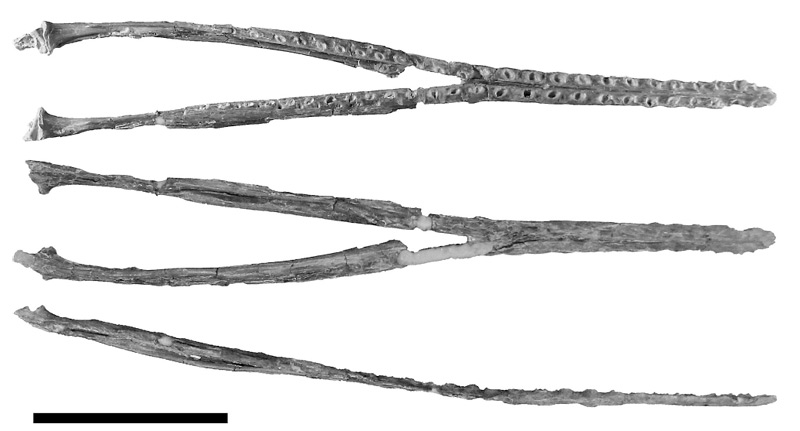[Recent Entries][Archive][Friends][User Info]
| Time | Text |
|---|---|
| 07:04 pm [Link] |
Aetodactylus Aetodactylus (meaning "eagle finger") is a genus of ornithocheirid pterodactyloid pterosaur. It is known from a lower jaw discovered in Upper Cretaceous rocks of northeastern Texas, United States. Aetodactylus is only the second ornithocheirid genus to be discovered in North America. Aetodactylus is based on SMU 76383 (Shuler Museum of Paleontology, Southern Methodist University), a nearly complete lower jaw lacking the right retroarticular process (the bony prong posterior to the jaw joint), part of the posterior end of the mandibular symphysis (where the two halves of the lower jaw meet), and all but two teeth. This specimen was found in 2006 by Lance Hall near a construction site in Mansfield, near Joe Pool Lake (recorded as SMU Loc. 424). The rock it was found in is a calcareous marine sandstone rich in mud–sized particles, from the middle Cenomanian-age (approximately 97 million years old) Tarrant Formation. Also found were fish teeth and vertebrae, and indeterminate bones. The Tarrant Formation is the lowest rock unit of the Cenomanian–Turonian–age Eagle Ford Group. Aetodactylus was named by Timothy S. Myers of SMU in 2010. The type species is A. halli, named in honor of the discoverer. Aetodactylus is differentiated from other ornithocheirids by several anatomical details of the lower jaw, including the slight expansion of the anterior end of the lower jaw, the strong vertical compression of the symphysis, the relatively constant spacing of the teeth, and the slight upward curve of the lower jaw. Myers found that Aetodactylus compared best with the Chinese genus Boreopterus. Aetodactylus represents one of the youngest definitive records of ornithocheirids. The jaw SMU 76383 is 38.4 centimetres (15.1 in) long, 15.8 centimetres (6.2 in) (~41%) of which is joined left and right jaws. 27 pairs of teeth were present; the two remaining teeth are pointed, curved slightly backward, flattened from side to side, and slender. The tip of the jaw is slightly expanded (to 1.6 centimetres (0.63 in) from a minimum of 1.3 centimetres (0.51 in) just posterior) and contains the first four pairs of teeth, with the first pair projecting forward. Based on the size of the tooth sockets, the teeth of the second and third pairs were largest, with tooth size decreasing posteriorly. There are small pits between the posterior teeth, interpreted as points where the teeth of the upper jaw rested against the lower jaw. These pits disappear partway along the tooth row, suggesting that the anterior teeth of the upper jaws were longer and projected outwards to a degree. Unlike some other ornithocheirids, such as Anhanguera, Coloborhynchus, and Ornithocheirus, there is no bony crest on the lower jaw. It is possible that Aetodactylus might be a boreopterid, as Myers identifies it as being closely related to Boreopterus, and many ornithocheirid remains might belong to boreopterids instead. 95 миллионов лет назад, в сеноманском веке позднего мела над обширным внутренним морем, разделявшим надвое Североамериканский континент, парил птерозавр. Это был крупный ящер – почти три метра в размахе крыльев. Он охотился на рыбу, выхватывая ее из воды длинной зубастой пастью. Но что-то случилось – что именно, мы уже, скорее всего, никогда не узнаем – и птерозавр оказался в воде. Может быть он упал сам – из-за болезни или по какой-то иной причине, а может быть, его ухватил высунувшийся из воды морской хищник – мозазавр. Но так или иначе, разрозненные кости птерозавра оказались на дне моря, среди раковин моллюсков и зубов акул. Статья, посвященная исследованию челюсти и описанию Aetodactylus halli опубликована в первом за текущий год номере издания Journal of Vertebrate Paleontology. Ornithocheiroidea is a group of pterosaurs within the extinct suborder Pterodactyloidea. Ornithocheiroids, like other pterosaurs, are considered to have been skilled fliers as well as adept at moving on the ground. Evidence from footprints shows that most pterosaurs did not sprawl their limbs to a large degree, as in modern reptiles, but rather held the limbs relatively erect when walking, like dinosaurs. While no ornithocheiroid footprints are known, it is likely that they also walked erect. Among pterosaurs, ornithocheiroids had unusually uneven limb proportions, with the forelimbs much longer than the hind limbs. This would likely have required them to use unique modes of locomotion when on the ground compared to other pterosaurs. It is possible that ornithocheiroids ran (but not walked) bipedally, or that they used a hopping gait. Pterosaur researcher Mike Habib has noted that the limbs proportions of ornithocheiroids like Anhanguera are consistent with hopping. Ornithocheiroids were among the last of the world's pterosaur faunas. The species Piksi barbarulna and a few potential pteranodonts and nyctosaurs have all been found dating from the Campanian to the Maastrichtian ages of the Late Cretaceous period. Pteranodontoidea is an extinct clade of ornithocheiroid pterosaurs from the Early Cretaceous to the Late Cretaceous (middle Barremian to middle Campanian stages) of Asia, Europe, North America and South America. It was named by Alexander Wilhelm Armin Kellner in 1996. In 2003, Kellner defined the clade as a node-based taxon consisting of the last common ancestor of Anhanguera, Pteranodon and all its descendants. Ornithocheiroidea is sometimes considered to be the senior synonym of Pteranodontoidea, however its depends on it definition. Ornithocheiroidea was originally defined as an apomorphy-based taxon by Christopher Bennett in 1994. Later, Kellner (2003) redefined it to represent the node of Anhanguera, Pteranodon, Quetzalcoatlus and Dsungaripterus. Later, David Unwin (2003) suggested a different definition, the node that contains Pteranodon longiceps and Istiodactylus latidens, thus making Pteranodontoidea a junior synonym of Ornithocheiroidea. Brian Andres (2008, 2010, 2014) in his analyses, converts Ornithocheiroidea using the definition of Kellner (2003) to avoid this synonymy. Ornithocheiridae is a group of pterosaurs within the suborder Pterodactyloidea. They were among the last pterosaurs to possess teeth.
|
| Reply: | |



